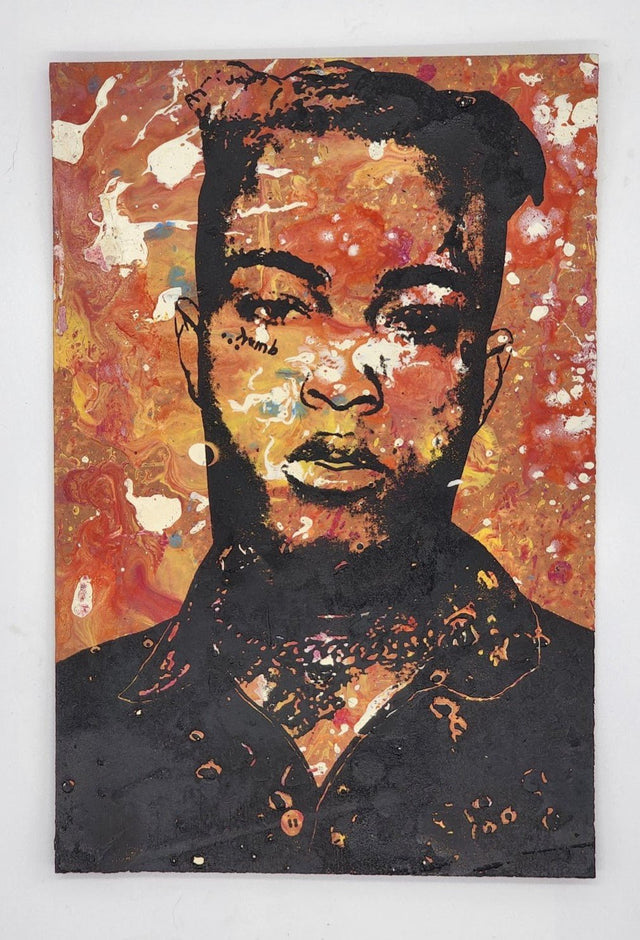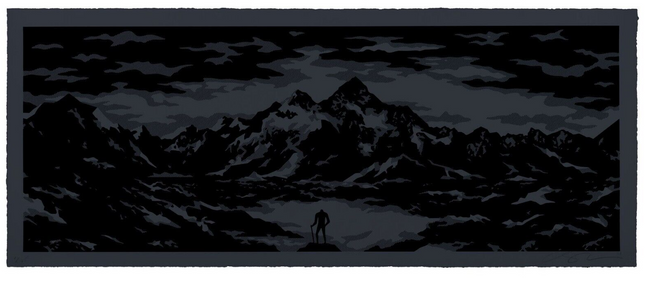
Man Male

Cleon Peterson The Reflection Black Silkscreen Print by Cleon Peterson
The Reflection Black Silkscreen Print by Cleon Peterson on Hand Deckled 290gsm Coventry Rag Fine Art Paper Limited Edition Artwork. 2021 Signed & Numbered Cleon Peterson Limited Edition of 125 Artwork Size 39X16 Silkscreen Print. The Limited Edition Silkscreen Art of Cleon Peterson Cleon Peterson's artistry is a powerful voice in the contemporary discourse of street pop and graffiti artwork. His 2021 creation, "The Reflection," is a testament to his distinct style and thematic concerns. This piece is a limited edition silkscreen print, with only 125 pieces available, each bearing Peterson's signature, which adds to the exclusivity and collectible nature of the artwork. These prints are emblazoned on hand-deckled 290gsm Coventry Rag fine art paper, known for its durability and premium quality, ensuring that each piece retains its depth and texture, which is significant in street art representation. The Aesthetic of "The Reflection" Cleon Peterson's "The Reflection" is visually striking, echoing the high-contrast aesthetic typical of street art. Black silkscreen ink gives the artwork a bold, graphic quality reminiscent of the dynamic visuals found in urban graffiti. At 39x16 inches, the print's substantial size allows viewers to immerse themselves in its stark world. Peterson employs a monochromatic palette, which adds visual impact and underscores the thematic dualities often explored in his work—order and chaos, violence and harmony, and power and subjugation. Peterson's composition places a solitary figure against an expanse of tumultuous landscape, a mountainous terrain that seems both majestic and oppressive. The use of negative space and the sharp delineation between the figure and its environment draws attention to the isolation of the individual within the space, a theme often explored in both street and pop art as they grapple with the individual's place in society. Context and Influence The artistic milieu from which "The Reflection" emerges is rich with historical and cultural significance. Cleon Peterson, an American artist, is renowned for his assertive approach that borrows street and pop art elements. His works do not shy away from the complexities of societal structures, often depicting scenes of conflict and strife that force the viewer to confront the darker aspects of human nature and societal interactions. Peterson's art does not exist in a vacuum but is part of a larger conversation about the nature of modern life and the individual's experience within it. By drawing on the motifs and methods of street art, which is historically linked to subversive and anti-establishment sentiments, Peterson's art challenges viewers to reconsider their perceptions of authority, community, and the self. The graffiti art form's traditional use of public spaces as a canvas is reflected in Peterson's choice to use silkscreen printing, a technique synonymous with the mass production and dissemination of images, thus merging the realms of high art and public discourse. Collectibility and Cultural Impact "The Reflection" is a visual feat and a collector's highlight. Its limited run and Peterson's autograph make each print a coveted piece for enthusiasts of street pop and graffiti artwork. The hand-deckled edges of the Coventry Rag paper offer a tangible connection to street art's hands-on, often rebellious nature, even within the confines of a private collection. The paper's texture and weight add a tactile dimension that elevates the print beyond a mere reproduction; it becomes an artifact, a piece of Peterson's world that one can own and display. In the landscape of contemporary art, Peterson's voice rings clear. His work, "The Reflection," is a powerful commentary on the human condition, society's ills, and the individual's role within the larger narrative. This print, nestled comfortably in the collection of 125, is more than just a visual statement—it is a piece of cultural conversation, encapsulating the ethos of street art's raw, unapologetic exploration of life's gritty realities. Cleon Peterson's art continues to resonate with those captivated by the intersection of street sensibility and pleasing art aesthetics. "The Reflection," with its stark beauty and complex commentary, is a significant piece within his work, offering a somber meditation on the nature of self and society. It bridges the artist's internal reflections and the external world's perceptions, inviting viewers to ponder their place within the ever-shifting tapestry of contemporary life.
$1,250.00


